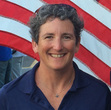Carol Newman Cronin's Blog, page 36
April 11, 2019
Muse Meets Snipe: April-versary
Last weekend, I competed in the Snipe Pan Am Trials off Fort Lauderdale, FL. Fresh breeze, salty swell, hot sunshine—my hands are still sore from trimming the mainsheet. With four days of practice leading up to a three day regatta, it was a rare opportunity to get a little bit faster each day—and also, just in case this isn’t already obvious, a fully absorbing, brain-consuming, ton of fun.
 Sunshine, wind, and waves: Fort Lauderdale is a sailor’s mecca. Photo courtesy Tom Rogers Pix
Sunshine, wind, and waves: Fort Lauderdale is a sailor’s mecca. Photo courtesy Tom Rogers PixBut as each busy sailing day wound down and I let my tired mind and body finally relax, I found my thoughts wandering north to Boston, where a very different learning opportunity was taking place.
Musing on The Muse
Last year, I spent the first weekend in April at Muse and the Marketplace, a writer’s conference that combines writing craft with the business of getting books out to readers. (Read April Confluence for more detail.) I made several new friends and learned a lot about where my fledgling manuscript might fit into the world of publishing—and most importantly, met my agent, April Eberhardt. Last Thursday morning, the day before both the Pan Am Trials and Muse 2019 began, I sent April an email wishing her a happy “April-versary.” She agreed it was hard to believe we’d met “just a year ago—we’ve accomplished so much since then, with many more triumphs ahead!”
Truth is stranger than fiction
Last year, over the four months between first connecting with April in an almost electric, visceral way at Muse 2018 and finally signing a contract, I learned that her husband was an avid sailor. Through a mutual friend, we eventually figured out that he’d delivered the same boat back from Hawaii that my husband raced there in 2012. (If I included such a coincidence in a novel, I’d be accused of adjusting facts for convenience.)

Shared Passion
On the surface, a writer’s conference and a high-level Snipe regatta wouldn’t appear to have much in common: inside vs. outside; Boston vs. Fort Lauderdale; cerebral vs. physical. But what I realized on the long drive home from Florida was that both include the same key ingredient: shared passion. My sailing friends would find Muse boring (stuck inside a crowded hotel, talking about writing craft and how to sell more books!). My writing friends would have trouble just rigging a Snipe—never mind navigating out through the crowded Port Everglades into the Atlantic, and hiking hard for three hour-long races.
Luckily, my life includes the space for both, and it’s rare that I have to choose between sailing and writing. I’m very glad I had the chance to learn so much about Snipe sailing last week… but I do wish I could’ve also sent my muse north to celebrate my April-versary in person. Next year!
Thanks to Tom Rogers for capturing the sailing action in Fort Lauderdale. See more at Tom Rogers Pix
April 4, 2019
Book Review: Come With Me
It’s not often that I find a book via a New Yorker review and then enjoy it as much as Come With Me, by Helen Schulman. (It’s also not often that I remember how I found such a book in the first place, but that’s another topic altogether.) This 2018 novel is about a family who lives in Palo Alto; the main character, Amy, works at a tech startup run by her best friend’s twenty-year-old son. That dynamic alone might make for a great story, but Amy has at-home challenges too: raising three boys (a teenager, and much younger twins who are lovingly referred to as Thing One and Thing Two), in the era of online access to everything. Oh, and did I mention that Amy’s husband is an unemployed print journalist who deserts the family just when they need him most?
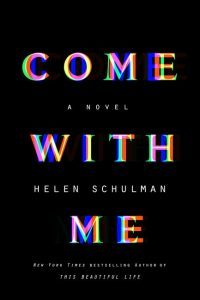
But wait, there’s more. The startup has built a virtual reality algorithm that gives users access to their “multiverses”—all the alternate story lines their lives could’ve taken. Testing the beta version is risky, but who could resist the chance to replay scenes from the past, making different choices or speaking different words? As the only employee old enough to have a past life, Amy is the logical guinea pig.
The book opens when she tells her initially unnamed boss: “I’m game… I’m in.”
“What do you want to know?” he said. He was tapping on his smartphone. His feet, in Adidas flip-flops, were tapping along with his fingers.
“When I was your age, I wanted to eat the world,” she said. “Love, heartbreak, I wanted to feel it all.”
He didn’t look up. Why should he? He wasn’t a feelings kind of guy. He was forever young, at least at that moment, so this was boring and he wasn’t listening anyway. She sounded like someone’s Aunt Sadie; she wouldn’t listen to herself. “Then for a long time, I didn’t want to feel any of it. But now I am at a point.”
At a point. A great example of the best thing about this book: Schulman trusts her readers to understand what’s not completely spelled out.
Following two divergent life paths is a concept I’ve always appreciated in movies (Me, Myself, I and Sliding Doors are particular favorites), and this 21st century VR version seems like a natural progression. Schulman’s explanation for her own fascination with “multiverses” made me better understand my own; in the author’s notes, she points out that “as a fiction writer, there are all these crazy, streaming, invented narratives that are forever playing out inside my head.” Aha! Another example of fiction that teaches me something about myself, even though both my life and writing are quite different from this book.
Layered well, with words that do the heavy lifting without ever bogging down the narrative, Come With Me digs into the shadows of Silicon Valley culture and the way tech has infiltrated our homes—by showing the chaos of everyday family life. Here’s the dinner table (takeout, again):
Jack [teenaged son] came in with the knives and forks and chopsticks. The Things loved chopsticks. Sometimes they even insisted on using them to eat cereal, shoveling the soggy flakes up like sodden leaves, drinking the milk down from the side of the bowl. Amy took two and used them to anchor her hair.
[Jack’s phone vibrates, announcing the virtual arrival at table of the absentee “family” member, his girlfriend Lily.]
“You’re tickling me,” he said to Lily.
“You’re ignoring me,” she said.
“Hi, Lily,” Amy called out. “Jack, put down the phone, and put your computer on the table so we can all see her.”
“Yes boss,” Jack said.
“Family dinner,” said Amy, into the phone. “I want everyone at the table. You know what all the articles say. Your SAT scores will go up.”
My only nitpick with the entire book is this: the author’s obsession with the Fukushima earthquake and subsequent nuclear disaster is allowed to take over the story more than necessary to move it forward. But since the details on-site in Japan are just as well-written as the rest, it’s a small complaint.
I would recommend this to anyone interested in exploring roads not taken, as well as those who are curious how “real” lives play out in the shadowed neighborhoods of Silicon Valley. I’d also recommend it to authors in search of the language to explain our crazy modern world. Come With Me is both page-turner and thought-provoker; the best possible combination.
Thanks for reading. I publish about one review a month and I’m always looking for the next book. Have you read anything you’d recommend? If so, add a comment below explaining why (no spoilers, please) or send me an email. Thanks!
Follow me on Goodreads or Bookbub
March 28, 2019
Spring into Sailing
A few years ago, I wrote in Scratching the Sailing Itch, “I can’t fix the world, so instead I will join my friends in another celebration of our shared passion for one-design competition.” Last week I did just that, shaking off the winter blahs at one of my favorite events: the DonQ Keg Rum Regatta in Miami, Florida.
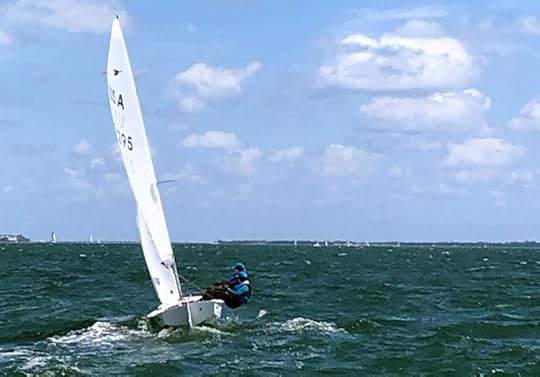 Ahh, Biscayne Bay breeze! Photo courtesy Leandro Spina
Ahh, Biscayne Bay breeze! Photo courtesy Leandro SpinaEvery year, this three day event brings teams to Miami from around the world, showcasing the international camaraderie and competition of the 80-plus year old Snipe class. Great sailing on Biscayne Bay is followed by a chance to socialize without leaving the grounds of the Coconut Grove Sailing Club. Those who want to fiddle with their boats can do so; thirstier competitors hang out at the upstairs bar. (Some combine the best of both by transporting their beverages down to the boat park.)
“As a life sport,” I pointed out in the fall of 2015, “sailing ebbs and flows through our schedules as time and opportunity permit.” The DonQ, coming right on the heels of the spring equinox, provides for me and many others an annual marker of the seasons changing.
One of the benefits of working for myself is being able to work from anywhere, so this year, instead of heading home right after the DonQ, I’m currently enjoying a little R&R in the Keys with—of all people—my husband! (For you regulars who noticed that this blog post is more than an hour behind schedule, take it as a sign that we’re really relaxing.)
Next week I’ll sail another regatta, the Pan Am Trials, out of Fort Lauderdale. Welcome, spring; a time of work, play—and scratching that sailing itch.
March 21, 2019
Audiobooks: A World of Their Own
Over the past few months, I’ve been sucked into the brave new world of audiobooks. Most book publishers offer an accompanying audio version, and the explosion of third-party services make it easier and easier to download a book to any portable device. (Though Audible is the most obvious subscription choice, you can support your local independent bookstore by joining libro.fm.) Thanks to Overdrive, you can even check audiobooks out of the library.

With all of this increased portability and decreased file size, we can now take our books along with us: on walks, flights, or in the car—even on the boat. (Eventually, digital assistants will be able to read us a book in voices realistic enough to be tolerable, but we’re not there yet.)
As an Author
I’m in the process of developing an audiobook for Oliver’s Surprise, which—if successful—will undoubtedly inspire an audiobook of Cape Cod Surprise, and perhaps even Game of Sails. We are already talking about the best approach to selling the audiobook rights for Ferry to Cooperation Island.
There are almost as many ways to develop an audiobook as there are ways to download the finished version, and learning about the process has been an education in itself; in addition to the usual publishing dos and donts, there are several new pitfalls to avoid. (Best example? I had to give up my initial fantasy of narrating the books myself.)
As a Reader
What fascinates me as a consumer of audiobooks is how differently I absorb with my ears than I do with my eyes. When I’m “just” listening, my mind tends to wander—unless my hands or feet are also accomplishing another goal. (I must admit, this is true of many conversations as well. Sorry Paul.) That makes audiobooks a great accompaniment for another activity, but not a great fit for bedtime reading—they put me to sleep.
Reading with my eyeballs requires full concentration. I don’t even do a good job of tuning out background noise.
As I learn to read with my ears, I’m realizing the best fit for me may be non-fiction. I recently listened to Educated, an excellent memoir that I might not have finished if I’d been reading it with my eyes. (I definitely would’ve skipped over some of the gory parts.) Currently I’m listening to What Editors Do. This content doesn’t replace the fiction I consume with my eyes; it’s becoming a way to add more reading time to my usual day.
Reading or Listening?
One question that doesn’t seem to have a good answer is whether it is possible to “read” audiobooks, or if the only proper description is “listen to.” Got an opinion, or a favorite type of audiobook? Leave a comment below, or send me an email. Thanks for reading!
March 14, 2019
Worlds Win Makes Hammer News
Last August, Kim Couranz and I (with coach Paul Cronin) won the Snipe Women’s Worlds on the last leg of the last race. This month, Hammer Nutrition featured the story in their excellent publication, Endurance News. I give a lot of credit for this victory to our fueling, which included all Hammer products on the water. As I put it in the opening paragraph,
I won’t bore you with the details, but I will tell you this: Hammer products (and all of that education along the way) just helped me win a world championship!

If we are, indeed, “old too soon and wise too late,” I consider personal fueling as part of the wisdom I’ve accumulated that helps me continue to achieve competitive sailing goals as I age. Because there are so many variables in sailboat racing, the benefits of fueling well do not always show in regatta results. But last August, on the fourth and windiest day of a World Championship, we light-air specialistas cemented a victory just by keeping our heads on straight. I know that fueling (along with sleep and fitness) played a huge part. Here’s how I put it for a non-sailing audience:
We were able to come back from mistakes, and to stay focused even at the end of each long day of a long championship. I believe that our consistent results were the direct result of consistent fueling and hydration.
Thanks Hammer! You’re a very important part of our team.
Read the full article in Endurance News
March 7, 2019
Adjectives: Lazy Shorthand or Powerhouse?
One of the many pieces of writing advice floating around the blogosphere is to reduce/eliminate adjectives and adverbs. Words that play a supporting role to other words are often a lazy shorthand for work better accomplished by the nouns and verbs themselves, especially if they fall into the category of cliché. Consider the relative strength of these two sentences:
He stepped lightly onto the small open motorboat.
He hopped aboard the center console.
While more dependent on boat knowledge, the second sentence is both stronger and easier to absorb.

Adjective Power
When used as a tactical shorthand, though, adjectives can be quite powerful all on their own. Last week, I submitted the first round of “tip sheets” to my publisher. The goal of these sheets is to give designers and editors a quick sense of what a book’s about, since most will have neither the time nor the interest to read the entire manuscript. I definitely expected to be asked for a short and long book description (see the back cover of any paperback.) Describing the main character also seemed like a no-brainer. What was quite unexpected was the request for “ten adjectives that describe your book”—and then, even more surprisingly, “ten adjectives that DO NOT describe your book.” (Scroll down to see what I chose.)
I filled out the forms, got feedback from agent and publicist, and then looked them over once again before sending. What struck me most on that final read-through was the strength of those two strings of adjectives—especially taken back to back. This “lazy shorthand” bookended the book’s tone, as well as the author’s vision for it, in a way that even the long description did not. Bypassing the writer’s need to polish and present the perfect prose provided a shortcut to the real “sense” of story.
Word-Hoards
A poem under my desk blotter by William Meredith entitled “What I Remember the Writers Telling Me When I Was Young” ends with, “The contrasts want to run together and must not be allowed to. They’re what you see with. Keep your word-hoard dry.” Adjectives, then, are crucial to my “word-hoard,” because they help our brains build a scene from words on the page. They may also be crutches, making it possible to avoid the hard work of finding stronger language, but—even as I write about a salt-sprayed world—I’ll try to keep them dry.
Ferry to Cooperation Island
10 adjectives that describe your book
salt-sprayed, self-contained, coastal, hopeful, sunny, small-town, upmarket, outdoorsy, car-less, ocean view
10 adjectives that do NOT describe your book
dark, horrible, graphic, citified, tropical, wintry, paved, frenzied, impersonal, clichéd
Got a pet peeve about adjectives, or think I missed something? Comment below, or send me an email. Thanks for reading!
February 28, 2019
Only One Jud (Smith)
When the February issue of Seahorse Magazine with my profile of Jud Smith showed up only an hour after he was named 2018 Rolex Yachtsman of the Year, I probably should’ve bought a lottery ticket. Can you say synchronicity?
 Jud Smith (red hat) won the 2018 J/70 Worlds in his home town. Photo courtesy Tim Wilkes
Jud Smith (red hat) won the 2018 J/70 Worlds in his home town. Photo courtesy Tim WilkesFour Decades of Perspective
As the article’s lead paragraph puts it, “Smith may be the English language’s most common surname, but in the keelboat phonebook there’s only one Jud.” I knew his name long before I first pestered him with rig tuning questions in 2002, and I’ve been cheering on his victories ever since. Last fall, I got to spend a few hours sitting in his “corner office” (a desk pushed out of the way of Doyle one design’s cutting table), listening to his perspective; what’s changed, and what hasn’t, over four decades of high level sailing. The result was this feature.
Rolex #2
Jud’s first Rolex dates back to 2006, the year he finally won the Etchells Worlds. The 2018 award was for winning the J/70 Worlds in his home town (on a boat called AFRICA, short for “Another Frickin’ Race Boat I Can’t Afford”). He also won the 2017 J/70 Worlds—as a 60 year old bow guy. Sailing keeps him young, he says; ” I get to go out and sail with a bunch of 30-year-olds. It’s just like being 30 again!”
 Jud (right) also won the 2017 J/70 Worlds as the bow guy for Peter Duncan’s team.
Jud (right) also won the 2017 J/70 Worlds as the bow guy for Peter Duncan’s team.Read the Article
Seahorse has given me permission to share Champion with my readers, but the only way to read Rod Davis’ thoughts on Objective>Gameplan>Execution is to subscribe. I appreciate the printed version enough to wait for its arrival toward the end of each month; if you’re not that patient, I’d recommend the (cheaper) digital subscription.
As for the one and only Jud, I can’t wait to see what he accomplishes in 2019.
Got a Jud story? Share it in the comments below, or send me an email. Thanks for reading!
February 21, 2019
No Building? No Problem
Last November, I took a trip to San Francisco that combined books with boats. (Read more in Ode to Ferries. ) The billable excuse was to write an article for Seahorse about the unique synergy that has become the Facility for Advanced Sail Training (FAST). The article appeared in the January 2019 issue of Seahorse and is reprinted here with permission.
For an international Olympic update, the January issue also includes an excellent Half Term Report by Andy Rice.
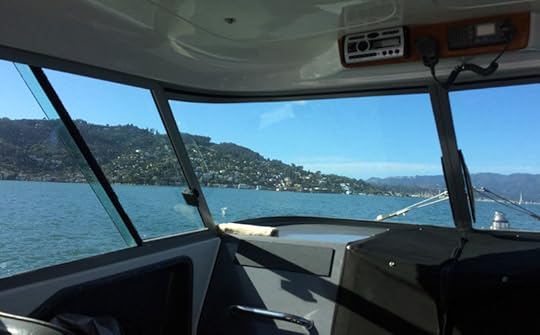
No Building No Problem
Do you really need a state of the art facility to train for the Olympics? Not if you’re FAST, says US Olympic Chief Malcolm Page.
In April 2018, three sailing organizations joined forces to launch the Facility for Advanced Sailing and Technology. FAST USA combines the synergies of San Francisco into a year-round Olympic sailing training program (and an awesome acronym). All three stakeholders (Treasure Island Sailing Center, the USSailing Team, and the St. Francis Yacht Club Foundation) admit that progress has been slower than hoped but finally things are moving apace.
History repeats
Treasure Island (TI), a man-made island with a fantastic view of downtown San Francisco, was created eighty years ago by heaping dredged fill onto ship-eating shoals north of the Bay Bridge. Built to host the 1939 Golden Gate Exposition, TI was also home to the Pan American Airlines flying boats (famous for island-hopping to Hong Kong in a record-breaking six days). But plans for a full-service airport were scrapped when the US Navy, in need of a “Portal to the Pacific” ahead of World War II, took over. In 1997 the Navy deeded the property back to the city, which planned for an island-wide redevelopment included community sailing.
Two decades later, the Treasure Island Sailing Center (TISC) has provided affordable access to the Bay for thousands of adults and kids from all walks of life. Their signature program gets inner-city fourth graders out sailing—most for the first time. “I grew up through a sailing club that was very local and community-orientated,” Chief of US Olympic Sailing (and double gold medalist) Malcolm Page says; “to me it was, take it as far as you want.”
TISC has already hosted events, including the 2000 US Olympic Trials. But until a new facility comes on line, they’ve made FAST welcome in their nondescript trailer-office and fenced-in boat park.
A is for Advanced
The FAST USA tagline, “From Puddles to Podiums,” captures the all-important goal of building a pathway to Olympic sailing. Carisa Harris, President of TISC, campaigned a Europe Dinghy in the early 1990s; her husband Nick Adamson is a 1996 Olympian. She’s very excited about FAST’s potential. “Kids that come up are going to drive themselves to be excellent in sailing, and Malcolm supports that. His leadership in that vision is really critical to this happening.” For entry-level sailors inspired by Olympic hopefuls the next step becomes a lot more obvious when it’s personified by a sailor launching from the same ramp. FAST will help Team USA win medals, but its true gold may lie in this close allegiance to TISC.
S is for Sailing
When the FAST stakeholders asked Page what was needed to get the program up and running, he told them his first priority was “the water, because that’s what matters the most.” By “the water,” he means San Francisco’s year-round sailing and the multiple options available within easy reach of Treasure Island; “There are three sailing venues with very different conditions, all within a thirty minute sail.
“Head north for moderate conditions on Berkeley Circle, or west to the City Front for the big breeze and big chop funneling through the Golden Gate. For light air and flat water, head south under the Bay Bridge; there’s usually about ten knots less wind in South Bay than on Berkeley Circle,” says Page.
Page’s second priority is access to the water. That’s currently partially solved by TISC’s floating ramp—though it’s currently only wide enough to launch one skiff at a time and not well situated for the prevailing westerlies. But the plan is to have a new ramp ASAP.
T is for Technology
San Francisco is obviously ideally placed for leading edge technology, says Page. The best example is AutoDesk, a leading technology firm with an innovation hub right on the city front. With so many engineers involved in high level sailing, the opportunities are “limitless,” with the potential for internships. “Come into Autodesk, use the software, actually get the practicality behind your education…”
Harris, a professor at UC Berkeley, agrees that local internships can help athletes build their CVs. “Schools and employers don’t really care if you’re on the US Sailing Team. They need you to be really good at what they need you to be good at, and that’s not necessarily sailing around buoys…”
F is for Facility
Here’s where a leap of faith is required to see FAST USA as a game-changer… Heading into 2019, even their “instant” temporary facility (six donated containers from Oracle’s America’s Cup village in Bermuda) was still in storage, held up by pesky details like long-term leases and overhead wires that need to be relocated.
FAST USA’s long-term plans include an Olympic training center with everything needed under one roof. Making it happen will require both vision and dogged persistence; Treasure Island is the subject of a massive “land-raising” exercise to stay ahead of any rise in sea-levels. An island can’t become San Francisco’s “newest greenest neighborhood” without being climate-change-proof… but city planners don’t work at Olympic pace.
Though a glitzy new building (or even a temporary container village) would certainly make it easier to visualize progress, FAST’s synergy of location and timing is already reaping benefits by creating a 21st century “Portal to the Pacific;” Treasure Island is one plane ride closer to Tokyo 2020 than Miami. And US sailors are also taking their Chief’s challenge to commit for 2024 and 2028.
“There’s so much potential here,” Page says. “This country, like no other, has every piece of the puzzle.” By combining gold-medal leadership with the long-term vision of FAST’s stakeholders, the future of US Olympic sailing looks a lot brighter than it has yet this century.
No building? No problem.
Book Review: Little Fires Everywhere
The best book recommendations come not as titles scribbled down during a conversation or links added to an email, but as fully-formed physical objects—delivered at regattas. Almost every time I see my world-champion friend Kim, she passes off a stack of books for my To Be Read (TBR) pile. Over the years I’ve learned that these recommendations often prove better than my own choices—especially the ones in the literary fiction wheelhouse.
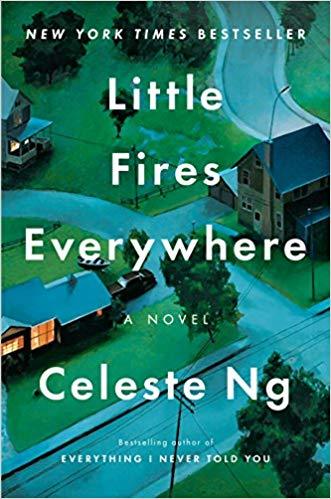
Last summer, Kim delivered a stack that stood, neglected, for six months. By the time I finally picked up Little Fires Everywhere, a rare hardback that I’d been eager to read since it came out in 2017, I first thought I’d purchased it myself (probably with my annual Christmas gift certificate from Island Books). It was only when I opened the flyleaf and found Kim’s name (code for “I want this back”) that I realized: this particular recommendation had overlapped exactly with one of the books already on my mental TBR list.
The story is about several families who live in Shaker Heights, Ohio, a planned community laid out in the 1950s whose occupants are expected to play by the rules. At first glance, the Richardsons are the epitome of Shaker Heights; three teenagers, a lawyer-father, and a reporter-mother who also grew up in the neighborhood. Fly-by-night artist Mia Warren and her teenaged daughter represent the opposite end of the lifestyle spectrum; they move into a rental house (belonging to the Richardsons) in search of a little more stability.
As the four kids’ lives become increasingly intertwined, several surprising and secret alliances develop. Into this fertile soil, author Celeste Ng plants an abandoned child who is adopted by another neighborhood family and later reclaimed by her birth mother. All the neighbors takes sides—overlaid with plenty of racial and class overtones and judgment. Sprinkle in a few more historical secrets that are gradually dug up by the mother-reporter, and the result is a page-turner that stirs up our pre-conceived notions about family.
But while our notions are stirred, they aren’t quite shaken. Characters don’t quite deepen enough to break away from stereotype. The artist is flighty; the suburban mother never thinks to question even the pettiest of Shaker Heights rules—like the one that specifies where garbage cans should be kept (out of sight behind the house, even on trash day). I found myself wishing for characters who were a little less predictable, who didn’t just consciously draw outside the expected lines but wrestled with a few internal contradictions as well.
With key points of view covering the range of perspectives, the story neatly unspirals into both recent and distant past—once the first chapter explains both the title and who lit all those little fires. When reviewing a book, I like to quote a particularly noteworthy passage; with this one, nothing stands above the rest. It’s all a steady, artful drumbeat of careful prose, building and layering toward the inevitable climax. Knowing the “who” and “what” up front frees the reader to ponder the “why,” as well as the occasional “why not.”
By covering so many sides of this timely story, Ng has plenty of latitude to delve into the most unanswerable question: what makes the best parent? And how much does the answer vary, depending on the child? Along the way, the author (who grew up in Shaker Heights and Pittsburgh) pokes a little lighthearted disdain at the idea of humans—who come in all sizes, colors, and schedules—conforming to such a carefully pre-planned ideal of a world.
I recommend this book to anyone who enjoys well-written family sagas and stories that make us reconsider our pre-conceived notions about family. I’m guessing Kim recommends it too, since she wants her copy back again. I won’t hand it over until I hear what she thought—which may well be wiser and deeper than what’s collected here.
Thanks for reading. I publish about one review a month and I’m always looking for the next book. Have you read anything you’d recommend? If so, add a comment below explaining why (no spoilers, please) or send me an email. Thanks!
Follow me on Goodreads or Bookbub
February 14, 2019
Finding Your Next Book
Here’s a Valentine’s Day question: how do you find your next good book?
I read about a book a week, year-round (though that doesn’t include the books I abandon after a few pages—or even halfway through). Right now, more books than I could possibly consume already clog up both my bedside table and my Kindle app. At other times, I struggle to find something that grabs me. It seems to go in phases.
No matter what phase I’m in, my next book comes from one of three sources:
 So many books, so little time…
So many books, so little time…Personal recommendations
I have one friend in particular who does more for my reading variety than anyone else, physically passing on books she has enjoyed. So many are books I wouldn’t have picked for myself, and yet I find myself drawn into each world by a synergy of words, ideas, and imagery—surprised into caring about something completely unexpected and outside of my own experience. The most memorable books take us places we couldn’t otherwise go.
Reviews
Like books themselves, there are just too many lists to keep track of… but there are a few key places where I find reviews that intrigue me. The New Yorker is kind of a “stretch” goal; many of the books reviewed there I find too heavy, or too heavy-handed, for bedtime reading. At the other end of the reviewing spectrum is Goodreads, where I try to at least rate every book I crack open (even those on my Did Not Finish list); feel free to follow along.
Physical Browsing
Though I find it hard to browse online, bookstores and libraries are like mecca. Armed with a Christmas gift certificate to Island Books (or just my library card), I wander through the shelves, sampling just enough of a tempting title to drop into a whole new world.
What to look for
A “good read” is quite personal, which is why recommendations from trusted sources are so valuable. When browsing, my first attraction point is the cover—but I always read at least the first page before buying or borrowing. If I’m still on the fence, I will page halfway through and read the first paragraph of a random chapter. The plot might not yet make any sense, but I will instantly know whether the book has been edited equally well all the way through.
Book browsing is not just a way to find my next bedtime story; it also teaches me what grabs a reader. So how do YOU find your next good read? Let me know in the comments below, or email me directly: carolncroninATgmailDOTcom. Thanks for reading!
To see what I’ve chosen for my next read, follow me on Goodreads

